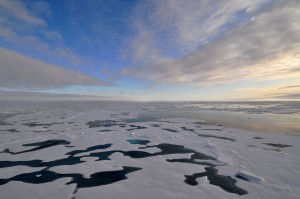15 December 2015
Restoring white Arctic will fall to future generations who never knew it
Posted by lhwang

As future generations exploit a blue Arctic, they may push back against the value of a white one.
Credit: Collection of Pablo Clemente-Colón, Chief Scientist at the U.S. National Ice Center, via NOAA’s flickr photo library.
by Natalie Jacewicz
Scientists and policymakers have discussed for decades how to slow the rate of global warming and melting Arctic ice—most recently at the Paris talks—but few have discussed how to restore the ice after it is lost. That task will likely fall to future generations who not only grew up without a white Arctic but may have conflicting interests in keeping it blue, according to an analysis presented on Monday by scientists at the 2015 American Geophysical Union Fall Meeting.
The case for a white Arctic and the groundwork for its restoration should be made now, according to Stephanie Pfirman, professor of environmental science at Barnard College and Columbia University, New York. Pfirman led a group of scientists in analyzing existing climate change literature. They compiled a list of future interests likely to support and oppose Arctic restoration and recommended current actions to make future restoration more probable.
Previous research suggests that carbon already released into the atmosphere will stay there for the next 20 years. This means that the Arctic will be essentially ice-free by 2040, with less than 1 million square kilometers (386,000 square miles) of ice during the summer, according to the analysis. The trend is unlikely to reverse immediately.
Pfirman said that one to two generations of humans will live in an ice-free Arctic world. “The question becomes, who would bring it back at that point?” she asked.
To answer that question, Pfirman’s team compiled a list of potential competing interests for future generations. Environmental groups will likely favor restoring lost ice, but shipping interests will probably lobby for open, blue waters, the authors said. Global coastal communities will likely support re-freezing waters to decrease erosion and flooding, but oil and mineral extractors may champion open waters for drilling. Some interests cut both ways: Tourists may value a white Arctic for its icy beauty, but could value a prevalently blue arctic for easy access to glaciers.
Pfirman’s team recommends investing in sustainable energy and carbon removal now to lower the hurdles to restoring Arctic ice.
“If you turn around CO2, you turn around the temperature pretty quickly,” said Bob Newton of the Lamont-Doherty Earth Observatory and Columbia, a scientist behind the analysis. Carbon dioxide takes a long time to decrease in the atmosphere, but once it does, lower temperatures and ice follow rapidly, he said.
The team also sees potential in developing “the right to regrow white,” according to Pfirman. Such a system would allow users to take advantage of a blue Arctic’s resources, but only with a contractual understanding that after a certain number of years, their access would end to make way for re-icing.
“The Arctic tends to be the climate flywheel for the globe,” said James Overland, an oceanographer at the National Oceanic and Atmospheric Association (NOAA) Pacific Marine Environmental Laboratory in Seattle. Overland performed some of the Arctic research informing the group’s analysis and recommendations.
He explained the importance of cooling the planet in sobering household terms. “If you remove all of the refrigerant from your refrigerator…everything will spoil.”
— Natalie Jacewicz is a science communications graduate student at the University of California, Santa Cruz. You can follow her on twitter at @NatalieJacewicz.










 GeoSpace is a blog on Earth and space science, managed by AGU’s Public Information staff. The blog features posts by AGU writers and guest contributors on all sorts of relevant science topics, but with a focus on new research and geo and space sciences-related stories that are currently in the news.
GeoSpace is a blog on Earth and space science, managed by AGU’s Public Information staff. The blog features posts by AGU writers and guest contributors on all sorts of relevant science topics, but with a focus on new research and geo and space sciences-related stories that are currently in the news.